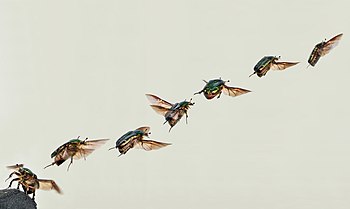User:Bernie Kohl/images/special
Special selection[edit]
The few out of the many to meet Ernie's standards for creating future-proof high quality images for public archives along with short “behind the scenes” stories.
Cetonia aurata “flight pattern”[edit]

The rose chafer is quite a recognizable beetle. Mainly due to its size and probably because of the difficult to overhear flight noise. In early spring 2009 I became interested in shooting close-ups of insects in flight. This was literally based on trial and error and it took me thousands of pictures to familiarize myself with the techniques required. Insects tend to move around unpredictable and with great speed. Shooting at magnifications of up to 1:3.5 makes it quite difficult to follow them with the camera. Another important aspect is being able to freeze the moment, which means fast shutter speeds (above 1/1000 of a second) and/or rear-curtain flash (flash that fires at the end of the exposure time).
I did not have any intention to shoot rose chafers, but the specimen in the picture presented itself to me by landing on my right shoulder and I took the chance and placed it on my close-up lens' bag. I had to shoot at 1/200th of a second which accounts for the little motion blur around the wings. A single flashgun was mounted on the camera – so a very basic setup. The background is a white wall – lit by ambient light it turned slightly green and I decided to add more yellow in post production, since it is only the background after all (no documentary value). The single shots were not taken in a row and I had to place the beetle on the bag, focus and wait for the lift-off several times. So strictly speaking it is by no means a scientifically accurate flight pattern but still a composition of seven images. The stitching itself was done in Photoshop and because of the matching backgrounds a simple copy and paste operation with minor adjustments like resizing and removing dust spots. --Ernie (talk) 17:00, 13 April 2010 (UTC)
![]() Positives: Composition, resolution, difficulty of the shot
Positives: Composition, resolution, difficulty of the shot
![]() Drawbacks: Motion blur, fill light, image noise, highlights
Drawbacks: Motion blur, fill light, image noise, highlights
Goat willow catkins[edit]

Goat willow (Salix caprea) has fascinated me ever since I first encountered it as a young child. I guess it's mainly due to the fluffy appearance of its flowers, which are known as catkins. Most children throughout Northwest and Central Europe use flowering willow branches in the ceremonies on Palm Sunday (due to the fact that there are not many palm leaves here). Therefore it is a commonly cultivated tree (or bush), yet it is difficult to find true goat willows since most of them are hybrids nowadays.
I decided to shoot the close-ups in a controlled environment which meant I had to cut the branch off a tree. Of course, I chose a healthy tree and went for a very small branch. Additionally I sealed the cut using tree wax. So – no worries, tree lovers. Close-ups of plants can often be a bit tricky. First of all one should avoid getting an unnatural perspective, since everyone is familiar with how plants grow. That's especially important when it comes to shooting directional parts like branches or stems. Another limiting factor is the narrow depth of field, which requires the subject to be as parallel to the film plane as possible. I used a basic three light setup with a green background light (yellow + green gel) bouncing off a white wall, one overhead softbox and a flash unit to the right. Although I stopped down to f/16 the depth of field was still too narrow and instead of stopping down further I decided to focus stack the picture to avoid diffraction. Due to the colored rim light I had to be careful not to get any spill onto the subject's surface, which was done by aligning the film plane (and subject) parallel to the background. The white balance was set to 5400K, which most flashes usually operate at. As I prefer to do it – sharpening in post production was avoided as much as possible, since I see sharpness as a lens characteristic and over-sharpening as quality-loss due to image optimization. --Ernie (talk) 21:27, 25 April 2010 (UTC)
![]() Positives: Colors, composition, resolution,
Positives: Colors, composition, resolution,
![]() Drawbacks: Depth of field despite focus stacking, highlights blown out, color spill from background light
Drawbacks: Depth of field despite focus stacking, highlights blown out, color spill from background light